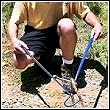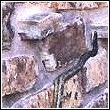Snakes
Meet The Snake
Snakes are fascinating animals, they can be dangerous under certain circumstances, but they can be quite beneficial too. The more you know about snakes the better you will be able to control them around your property, for instance, did you know that snakes can climb walls and get into your attic? Or that a cottonmouth with his mouth wide open is letting you know that he feels threatened? We've got lots of important snake control information here for you and info on our services too.
Snake facts are interesting to know, and important to understand for safety reasons too. The Wildlife Whisperer team is highly trained and experienced when it comes to snake control and we love working with them. When snakes become a problem we can help.
Venomous Snakes In Southwest Florida
There are two kinds of venomous snakes in Southwest Florida that can be classified as pit vipers, the cottonmouth (Agkistrodon piscivorus), also referred to as a water moccasin, and the rattlesnake.
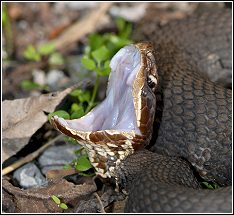
Showing Cottonmouth And Fangs
The copperhead (Agkistrodon contortrix) snake can also be found in Florida, it is also a venomous pit viper but is only found in the northern part of the state. The coral snake which can also be deadly, is also a venomous snake but is not a pit viper.
To avoid any confusion, all four snakes are dangerous - the coral snake, copperhead, cottonmouth and rattlesnake - and they can all be deadly. The question is, which one is a pit viper and which one is not. In Florida, all venomous snakes are pit vipers, except for the coral snake.
The fangs on a pit viper are designed for fast, efficient delivery of venom, and the fangs retract when not in use. The pit viper bites, delivers the venom in an instant, and quickly lets go.
The coral snakes fangs are structured differently and not as efficient at quick venom delivery as the pit viper, so when they bite, they hold on a bit and make chewing motions while doing so. Regardless of delivery, a coral snakes bite can be deadly and all snakes should be approached as venomous (harmful), and handled only by professionals.
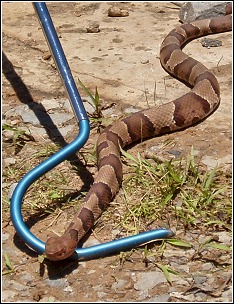
The term "poisonous" is often used to describe a venomous snake, in which case the term "poisonous" is being used in error. There is actually a distinct difference between the definition of the two words. The word venomous describes an animal's ability to "inject" venom into a wound, in the case of a snake, its fangs would create a wound and then inject the venom into it. Like many poisons, depending on the animal, the venom received during a snake bite can be deadly.
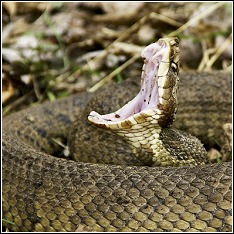
Mouth Open Ready To Strike
The cottonmouth snake, pictured just above, is sometimes called a water moccasin. Cottonmouths are a heavy bodied water snake - but not all Florida water snakes are cottonmouths. A cottonmouth often swims on top of the water with their head in the air. The cottonmouth snake gets its nickname from their defensive habit of opening their mouth to expose it's white lining when threatened, as seen in the photo above.
The rattlesnake is often associated with Arizona, New Mexico and the dry desert states. However, several species of rattlesnake can be found throughout the state of Florida. Rattlesnakes get their name from the rattle sound their tail makes when threatened.
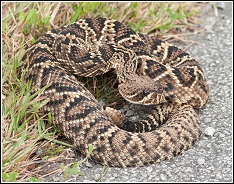
Rattlesnake on Florida Road
There are three varieties of rattlesnakes in Florida, the pygmy (Sistrurus miliarius), eastern (Crotalus adamanteus), and timber (Crotalus horridus) rattlesnake. A canebreak rattlesnake is just another name for the timber variety. Of the three kinds of rattlesnakes found in Florida, the eastern diamondback is the largest (heaviest).
The eastern coral snake (Micrurus fulvius) is a colorful but reclusive snake. Because they are easily noticable, reclusive and don't have as good a venom delivery sytem as a pit viper, you seldom hear of death related coral snake encounters. Just the same, their venom is highly toxic, so under the right circumstances, a coral snake bite can be deadly, and you should approach any encounter with them as hazardous.
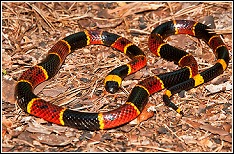
The Forest Floor In Florida
A coral snake doesn't have the same characteristic features that a pit viper has, that is the features usually used to identify a venomous snake. Coral snakes don't have the triangular head, heat sensor pit, or elliptical pupils that pit vipers have. Instead, a coral snake has a spoon shaped head, no heat sensors and round pupils. This is because a coral snake is not a pit viper and does not deliver venom as such.
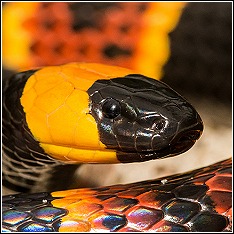
Showing Black Head And Markings
There are many non-venomous snakes that "mimic" the coral snake somewhat in appearance, but if you know what to look for the difference is easy to distinguish. Non-venomous varieties also have colorful bands and markings but the colors are arranged differently. There are all kinds of jingles out there to help you distinguish between the two, but the truth is it is better to play it safe and approach all snakes as venomous.
Coral snakes are on the reclusive side, and like to hide under logs and leaf piles on the ground, but they can also swim and have been found taking a dip in Florida swimming pools on more than one occasion.
All four kinds of venomous snakes found in Florida can and do swim, including the copperhead and rattlesnake varieties.
Many are surprised to find out that rattlesnakes swim, but they are actually quite adept at it and can even bite underwater.
For the most part, venomous snakes swim with their heads up and their bodies "floating" on top of the water, as seen below. This is because venomous snakes tend to swim with their lungs inflated.
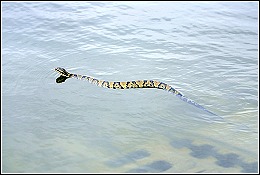
Non-venomous snakes tend to swim with their bodies submerged or along the surface with their heads level with the water.
But it is important to note, some venomous snakes such as water moccasins will occasionally dive underneath the water to catch fish - so as always, it is best to play it safe and assume all snakes are venomous - even if they are swimming with their bodies submerged.
When boating, it is always smart to be wary of tree canopies next to the water. Snakes are not likely to leap out of the water into your boat, but they can on occasion drop or fall, intentionally or unintentionally, off of a tree branch into a boat passing by underneath.
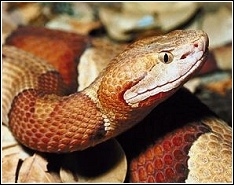
Pythons And Boa Constrictors In Florida
Venomous snakes may not be the only kind of snakes to worry about in Southwest Florida these days. In recent, years more and more Burmese pythons, yellow anacondas and boa constrictors have been discovered running free and threatening area pets and wildlife.
Pythons and Boas most likely got their start in Florida when they were released into the wild by dissatisfied pet owners.
These large snakes, grow rapidly, breed productively, have few predators in the area, and can adapt and thrive in just about any southern Florida habitat - including rural, suburb or urban environments.
Eventually they developed breeding populations, and today, they are exponentially increasing in population each year. With the exception of alligators, crocodiles and humans, pythons have few to no predators in the area to worry about. They breed easily, and today it is believed there may be well over 100,000 pythons in Florida.
The Burmese python preys on birds, mammals, other wildlife and pets. Animals that can fall victim include foxes, opossums, raccoons, dogs, cats, bobcats, rabbits, deer and other similar sized mammals.
Pythons between 12 and 20 feet in length and can weight up to 250 lbs. The largest python caught in Florida was 16' and 150 lbs.
Currently, they are most prolific in the Everglades and the majority are found in the southern 1/3 of the state.
Fun & Interesting Facts About Snakes
There are so many interesting facts about snakes and the snake information available today is fascinating.
Snakes are reptiles which puts them in the same animal family as turtles, lizards and crocodiles.
The term “poisonous” is a quite commonly used verbiage to describe snakes with fangs and venom, those we think of as dangerous and poisonous, however the word “venomous” is actually the correct term.
Snakes are known for crawling along the ground but they can be quite good at climbing up trees, walls and other surfaces to reach attics and other high resting areas.
The snake in the photo below was discovered by the Wildlife Whisperer in a client's garage door mechanism attached to the ceiling.

Snakes have most of the same internal bodily organs that we do, including a heart, lungs, gall bladder, kidney, pancreas and stomach, but they do not have eyelids, external protruding ears, arms or legs.
They are not slimy but are covered with smooth to the touch armor like plates (scales) that help protect them from hot sand, tree bark, rocks and other rough surfaces. Snakes moult, which means they shed their skin seasonally during the year, at which time a new layer, waiting and ready, immediately takes over.
All snakes use their tongue to smell and analyze their surrounding environment, including for prey and intruders such as humans. They also detect vibrations in the ground and air to help determine the size of available prey or other approaching animal. Some snakes, including most poisonous ones, have an infrared sensing function that allows them to locate warm blooded prey and other such animals that generate heat.
Snakes move by contracting and releasing their muscles, moving forward or sideways quickly. In spite of popular belief, snakes do not chase humans, but they may move toward a person if that person is between them and where they want to go. And snakes will defend themselves if threatened, cornered or surprised.
Snakes enjoy the warmth of the sun, the snake in the below photo was spotted by The Wildlife Whisperer taking a moment to sunbathe a bit.
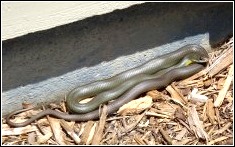
Relaxing In The Sun
A snake’s teeth are not used for chewing, but rather for grabbing or hooking their prey, where it is then swallowed whole. A snake’s jaws are not rigidly connected at the back which allows them to expand and swallow prey larger than their own head. All Florida snakes have teeth but only venomous ones have fangs. The fangs are connected to sacks of poison that it releases into the prey when the victim is bitten.
1242 SW Pine Island Rd., Suite 310
Cape Coral, Florida 33991-2126
help@totalwildlifecontrol.com



